Human Resource Development Report: Training and Development Analysis
VerifiedAdded on 2020/06/04
|15
|3874
|48
Report
AI Summary
This report on Human Resource Development (HRD) provides a comprehensive analysis of various learning theories and styles utilized within the HR department. The report examines different learning styles such as Kolb's and Honey & Mumford's, and their application in employee training. It details the role of learning curves and the importance of transferring learned skills to the workplace. The report also compares training needs across different staff levels and assesses the advantages and disadvantages of various training methods, emphasizing a systematic approach to planning and evaluating training events, with a case study on Nestle. Furthermore, it explores evaluation techniques, reviews the success of evaluation methods, and discusses the role of government in learning and competency development, including contemporary training initiatives introduced by the UK government.
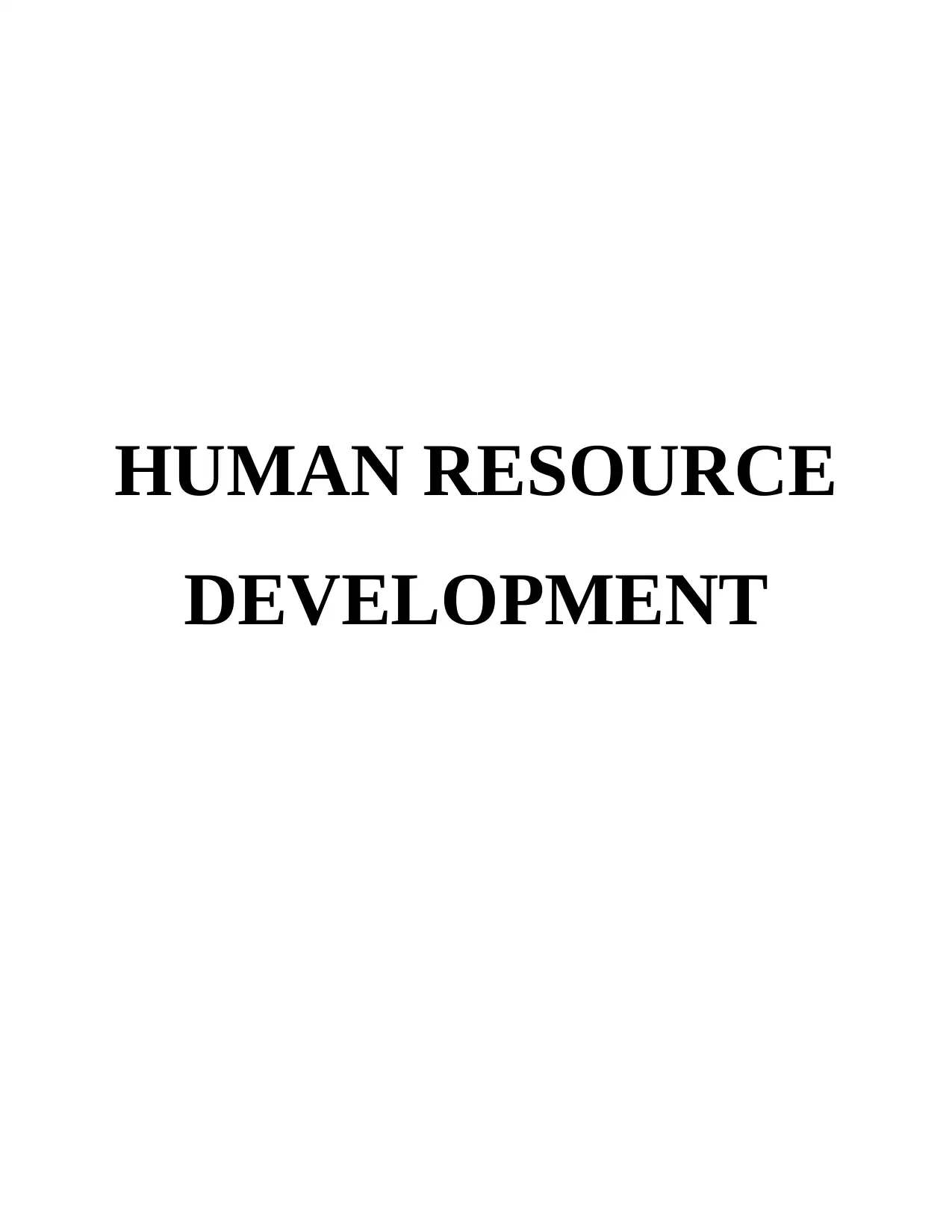
HUMAN RESOURCE
DEVELOPMENT
DEVELOPMENT
Paraphrase This Document
Need a fresh take? Get an instant paraphrase of this document with our AI Paraphraser
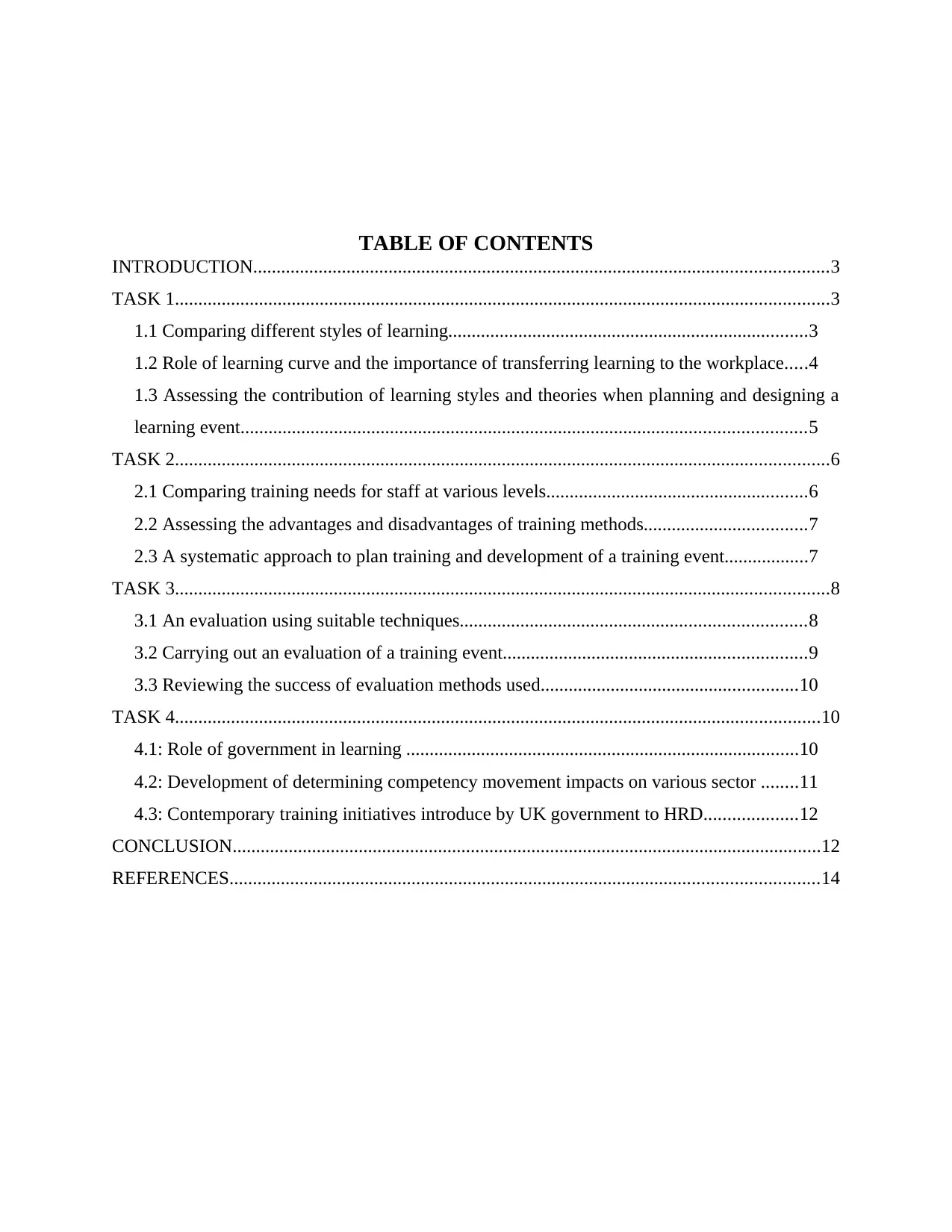
TABLE OF CONTENTS
INTRODUCTION...........................................................................................................................3
TASK 1............................................................................................................................................3
1.1 Comparing different styles of learning.............................................................................3
1.2 Role of learning curve and the importance of transferring learning to the workplace.....4
1.3 Assessing the contribution of learning styles and theories when planning and designing a
learning event.........................................................................................................................5
TASK 2............................................................................................................................................6
2.1 Comparing training needs for staff at various levels........................................................6
2.2 Assessing the advantages and disadvantages of training methods...................................7
2.3 A systematic approach to plan training and development of a training event..................7
TASK 3............................................................................................................................................8
3.1 An evaluation using suitable techniques..........................................................................8
3.2 Carrying out an evaluation of a training event.................................................................9
3.3 Reviewing the success of evaluation methods used.......................................................10
TASK 4..........................................................................................................................................10
4.1: Role of government in learning ....................................................................................10
4.2: Development of determining competency movement impacts on various sector ........11
4.3: Contemporary training initiatives introduce by UK government to HRD....................12
CONCLUSION..............................................................................................................................12
REFERENCES..............................................................................................................................14
INTRODUCTION...........................................................................................................................3
TASK 1............................................................................................................................................3
1.1 Comparing different styles of learning.............................................................................3
1.2 Role of learning curve and the importance of transferring learning to the workplace.....4
1.3 Assessing the contribution of learning styles and theories when planning and designing a
learning event.........................................................................................................................5
TASK 2............................................................................................................................................6
2.1 Comparing training needs for staff at various levels........................................................6
2.2 Assessing the advantages and disadvantages of training methods...................................7
2.3 A systematic approach to plan training and development of a training event..................7
TASK 3............................................................................................................................................8
3.1 An evaluation using suitable techniques..........................................................................8
3.2 Carrying out an evaluation of a training event.................................................................9
3.3 Reviewing the success of evaluation methods used.......................................................10
TASK 4..........................................................................................................................................10
4.1: Role of government in learning ....................................................................................10
4.2: Development of determining competency movement impacts on various sector ........11
4.3: Contemporary training initiatives introduce by UK government to HRD....................12
CONCLUSION..............................................................................................................................12
REFERENCES..............................................................................................................................14
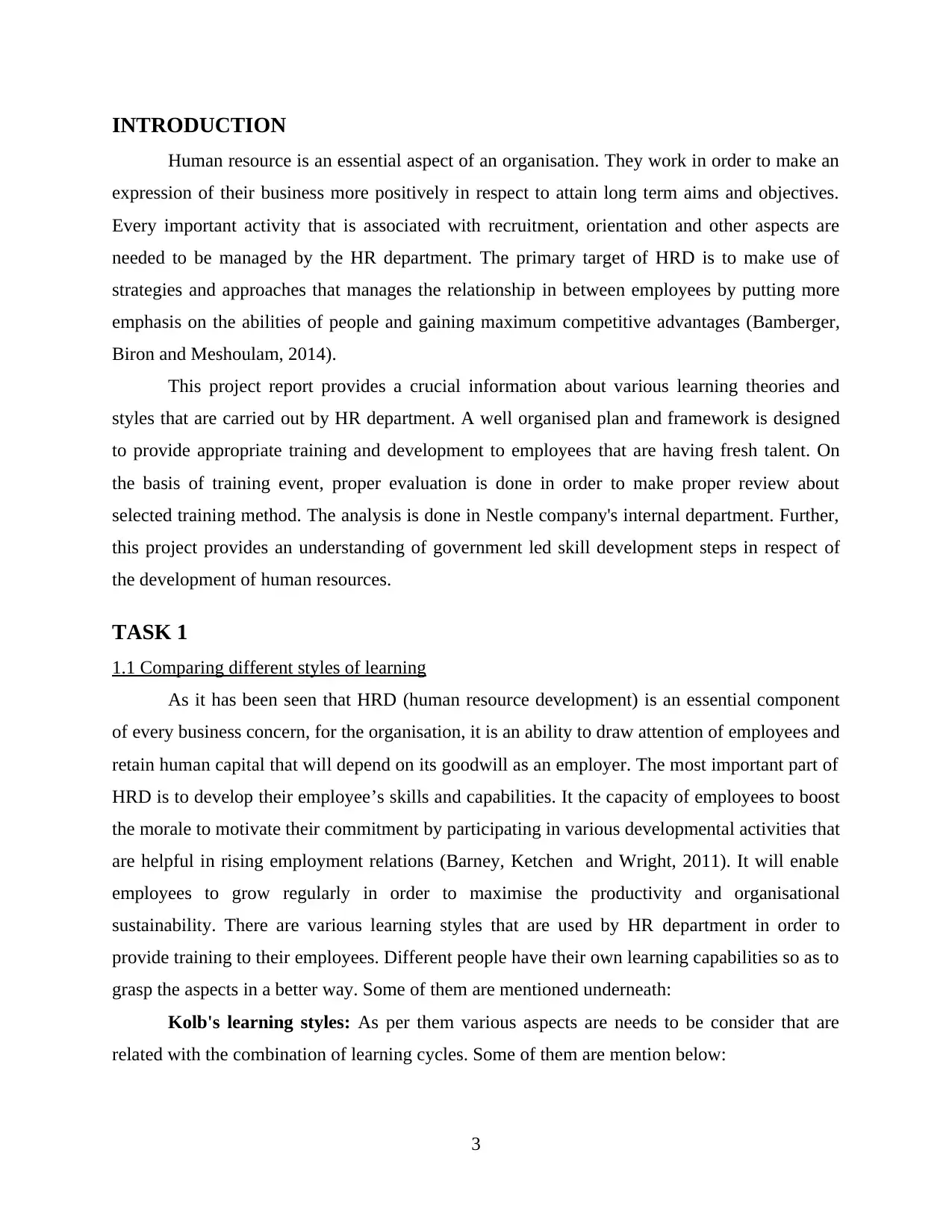
INTRODUCTION
Human resource is an essential aspect of an organisation. They work in order to make an
expression of their business more positively in respect to attain long term aims and objectives.
Every important activity that is associated with recruitment, orientation and other aspects are
needed to be managed by the HR department. The primary target of HRD is to make use of
strategies and approaches that manages the relationship in between employees by putting more
emphasis on the abilities of people and gaining maximum competitive advantages (Bamberger,
Biron and Meshoulam, 2014).
This project report provides a crucial information about various learning theories and
styles that are carried out by HR department. A well organised plan and framework is designed
to provide appropriate training and development to employees that are having fresh talent. On
the basis of training event, proper evaluation is done in order to make proper review about
selected training method. The analysis is done in Nestle company's internal department. Further,
this project provides an understanding of government led skill development steps in respect of
the development of human resources.
TASK 1
1.1 Comparing different styles of learning
As it has been seen that HRD (human resource development) is an essential component
of every business concern, for the organisation, it is an ability to draw attention of employees and
retain human capital that will depend on its goodwill as an employer. The most important part of
HRD is to develop their employee’s skills and capabilities. It the capacity of employees to boost
the morale to motivate their commitment by participating in various developmental activities that
are helpful in rising employment relations (Barney, Ketchen and Wright, 2011). It will enable
employees to grow regularly in order to maximise the productivity and organisational
sustainability. There are various learning styles that are used by HR department in order to
provide training to their employees. Different people have their own learning capabilities so as to
grasp the aspects in a better way. Some of them are mentioned underneath:
Kolb's learning styles: As per them various aspects are needs to be consider that are
related with the combination of learning cycles. Some of them are mention below:
3
Human resource is an essential aspect of an organisation. They work in order to make an
expression of their business more positively in respect to attain long term aims and objectives.
Every important activity that is associated with recruitment, orientation and other aspects are
needed to be managed by the HR department. The primary target of HRD is to make use of
strategies and approaches that manages the relationship in between employees by putting more
emphasis on the abilities of people and gaining maximum competitive advantages (Bamberger,
Biron and Meshoulam, 2014).
This project report provides a crucial information about various learning theories and
styles that are carried out by HR department. A well organised plan and framework is designed
to provide appropriate training and development to employees that are having fresh talent. On
the basis of training event, proper evaluation is done in order to make proper review about
selected training method. The analysis is done in Nestle company's internal department. Further,
this project provides an understanding of government led skill development steps in respect of
the development of human resources.
TASK 1
1.1 Comparing different styles of learning
As it has been seen that HRD (human resource development) is an essential component
of every business concern, for the organisation, it is an ability to draw attention of employees and
retain human capital that will depend on its goodwill as an employer. The most important part of
HRD is to develop their employee’s skills and capabilities. It the capacity of employees to boost
the morale to motivate their commitment by participating in various developmental activities that
are helpful in rising employment relations (Barney, Ketchen and Wright, 2011). It will enable
employees to grow regularly in order to maximise the productivity and organisational
sustainability. There are various learning styles that are used by HR department in order to
provide training to their employees. Different people have their own learning capabilities so as to
grasp the aspects in a better way. Some of them are mentioned underneath:
Kolb's learning styles: As per them various aspects are needs to be consider that are
related with the combination of learning cycles. Some of them are mention below:
3
⊘ This is a preview!⊘
Do you want full access?
Subscribe today to unlock all pages.

Trusted by 1+ million students worldwide
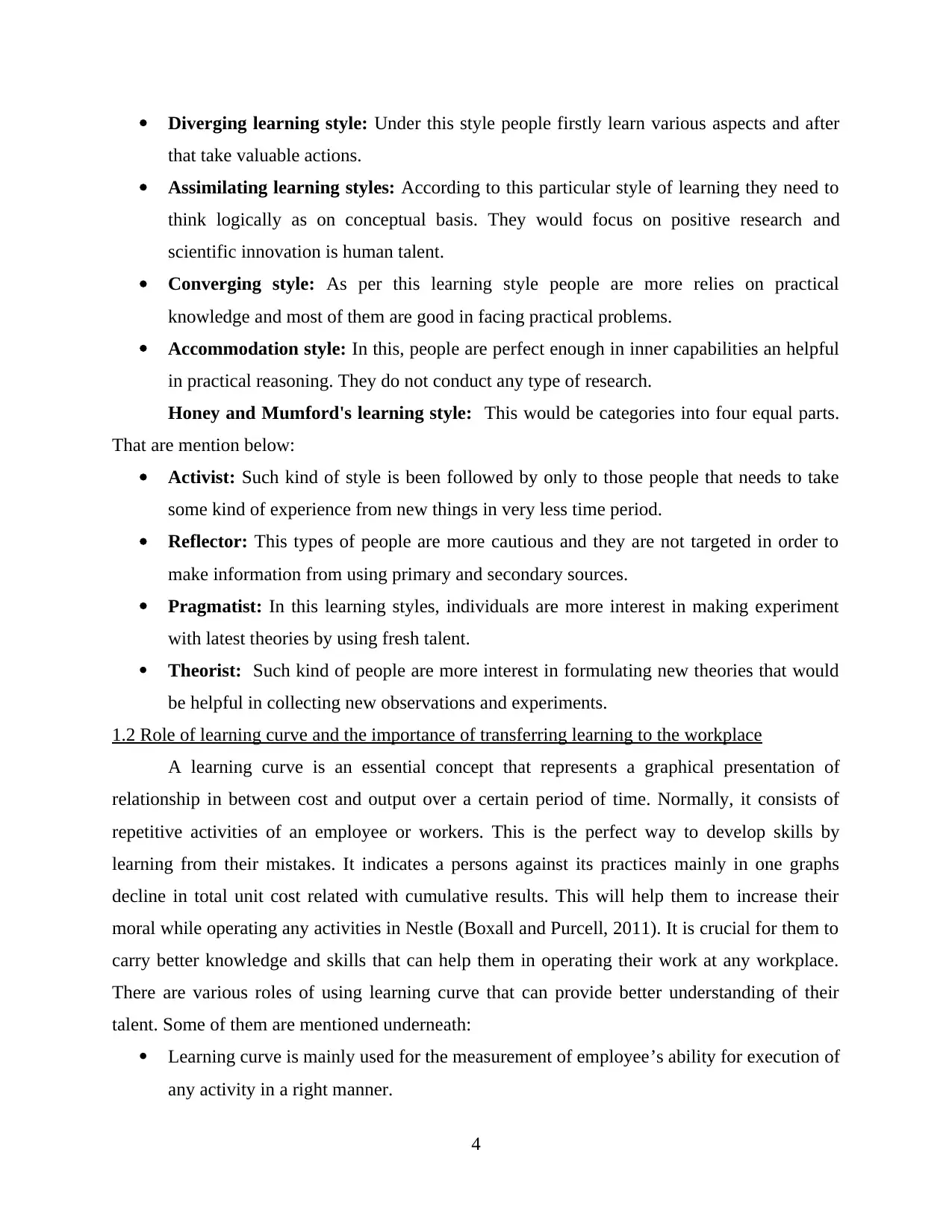
Diverging learning style: Under this style people firstly learn various aspects and after
that take valuable actions.
Assimilating learning styles: According to this particular style of learning they need to
think logically as on conceptual basis. They would focus on positive research and
scientific innovation is human talent.
Converging style: As per this learning style people are more relies on practical
knowledge and most of them are good in facing practical problems.
Accommodation style: In this, people are perfect enough in inner capabilities an helpful
in practical reasoning. They do not conduct any type of research.
Honey and Mumford's learning style: This would be categories into four equal parts.
That are mention below:
Activist: Such kind of style is been followed by only to those people that needs to take
some kind of experience from new things in very less time period.
Reflector: This types of people are more cautious and they are not targeted in order to
make information from using primary and secondary sources.
Pragmatist: In this learning styles, individuals are more interest in making experiment
with latest theories by using fresh talent.
Theorist: Such kind of people are more interest in formulating new theories that would
be helpful in collecting new observations and experiments.
1.2 Role of learning curve and the importance of transferring learning to the workplace
A learning curve is an essential concept that represents a graphical presentation of
relationship in between cost and output over a certain period of time. Normally, it consists of
repetitive activities of an employee or workers. This is the perfect way to develop skills by
learning from their mistakes. It indicates a persons against its practices mainly in one graphs
decline in total unit cost related with cumulative results. This will help them to increase their
moral while operating any activities in Nestle (Boxall and Purcell, 2011). It is crucial for them to
carry better knowledge and skills that can help them in operating their work at any workplace.
There are various roles of using learning curve that can provide better understanding of their
talent. Some of them are mentioned underneath:
Learning curve is mainly used for the measurement of employee’s ability for execution of
any activity in a right manner.
4
that take valuable actions.
Assimilating learning styles: According to this particular style of learning they need to
think logically as on conceptual basis. They would focus on positive research and
scientific innovation is human talent.
Converging style: As per this learning style people are more relies on practical
knowledge and most of them are good in facing practical problems.
Accommodation style: In this, people are perfect enough in inner capabilities an helpful
in practical reasoning. They do not conduct any type of research.
Honey and Mumford's learning style: This would be categories into four equal parts.
That are mention below:
Activist: Such kind of style is been followed by only to those people that needs to take
some kind of experience from new things in very less time period.
Reflector: This types of people are more cautious and they are not targeted in order to
make information from using primary and secondary sources.
Pragmatist: In this learning styles, individuals are more interest in making experiment
with latest theories by using fresh talent.
Theorist: Such kind of people are more interest in formulating new theories that would
be helpful in collecting new observations and experiments.
1.2 Role of learning curve and the importance of transferring learning to the workplace
A learning curve is an essential concept that represents a graphical presentation of
relationship in between cost and output over a certain period of time. Normally, it consists of
repetitive activities of an employee or workers. This is the perfect way to develop skills by
learning from their mistakes. It indicates a persons against its practices mainly in one graphs
decline in total unit cost related with cumulative results. This will help them to increase their
moral while operating any activities in Nestle (Boxall and Purcell, 2011). It is crucial for them to
carry better knowledge and skills that can help them in operating their work at any workplace.
There are various roles of using learning curve that can provide better understanding of their
talent. Some of them are mentioned underneath:
Learning curve is mainly used for the measurement of employee’s ability for execution of
any activity in a right manner.
4
Paraphrase This Document
Need a fresh take? Get an instant paraphrase of this document with our AI Paraphraser
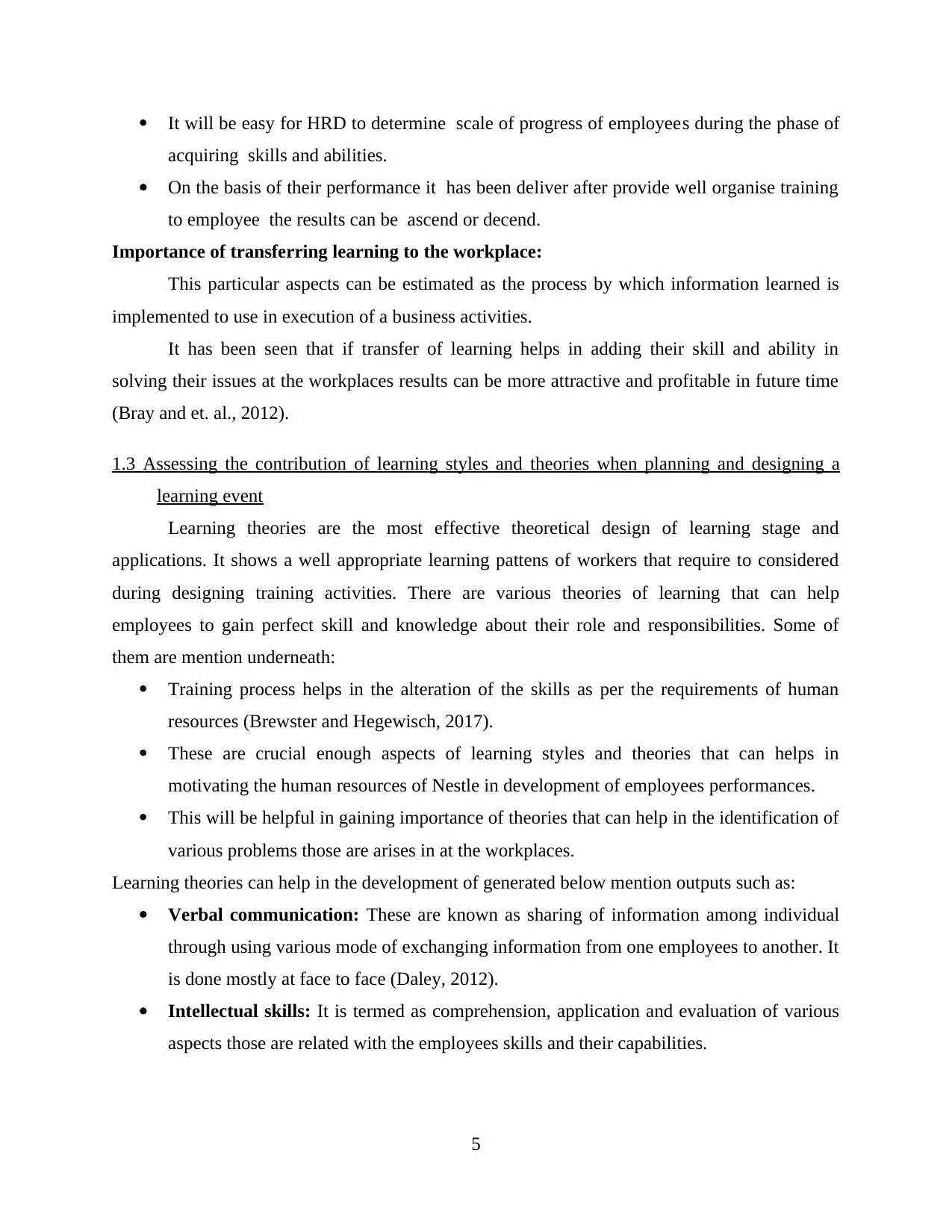
It will be easy for HRD to determine scale of progress of employees during the phase of
acquiring skills and abilities.
On the basis of their performance it has been deliver after provide well organise training
to employee the results can be ascend or decend.
Importance of transferring learning to the workplace:
This particular aspects can be estimated as the process by which information learned is
implemented to use in execution of a business activities.
It has been seen that if transfer of learning helps in adding their skill and ability in
solving their issues at the workplaces results can be more attractive and profitable in future time
(Bray and et. al., 2012).
1.3 Assessing the contribution of learning styles and theories when planning and designing a
learning event
Learning theories are the most effective theoretical design of learning stage and
applications. It shows a well appropriate learning pattens of workers that require to considered
during designing training activities. There are various theories of learning that can help
employees to gain perfect skill and knowledge about their role and responsibilities. Some of
them are mention underneath:
Training process helps in the alteration of the skills as per the requirements of human
resources (Brewster and Hegewisch, 2017).
These are crucial enough aspects of learning styles and theories that can helps in
motivating the human resources of Nestle in development of employees performances.
This will be helpful in gaining importance of theories that can help in the identification of
various problems those are arises in at the workplaces.
Learning theories can help in the development of generated below mention outputs such as:
Verbal communication: These are known as sharing of information among individual
through using various mode of exchanging information from one employees to another. It
is done mostly at face to face (Daley, 2012).
Intellectual skills: It is termed as comprehension, application and evaluation of various
aspects those are related with the employees skills and their capabilities.
5
acquiring skills and abilities.
On the basis of their performance it has been deliver after provide well organise training
to employee the results can be ascend or decend.
Importance of transferring learning to the workplace:
This particular aspects can be estimated as the process by which information learned is
implemented to use in execution of a business activities.
It has been seen that if transfer of learning helps in adding their skill and ability in
solving their issues at the workplaces results can be more attractive and profitable in future time
(Bray and et. al., 2012).
1.3 Assessing the contribution of learning styles and theories when planning and designing a
learning event
Learning theories are the most effective theoretical design of learning stage and
applications. It shows a well appropriate learning pattens of workers that require to considered
during designing training activities. There are various theories of learning that can help
employees to gain perfect skill and knowledge about their role and responsibilities. Some of
them are mention underneath:
Training process helps in the alteration of the skills as per the requirements of human
resources (Brewster and Hegewisch, 2017).
These are crucial enough aspects of learning styles and theories that can helps in
motivating the human resources of Nestle in development of employees performances.
This will be helpful in gaining importance of theories that can help in the identification of
various problems those are arises in at the workplaces.
Learning theories can help in the development of generated below mention outputs such as:
Verbal communication: These are known as sharing of information among individual
through using various mode of exchanging information from one employees to another. It
is done mostly at face to face (Daley, 2012).
Intellectual skills: It is termed as comprehension, application and evaluation of various
aspects those are related with the employees skills and their capabilities.
5
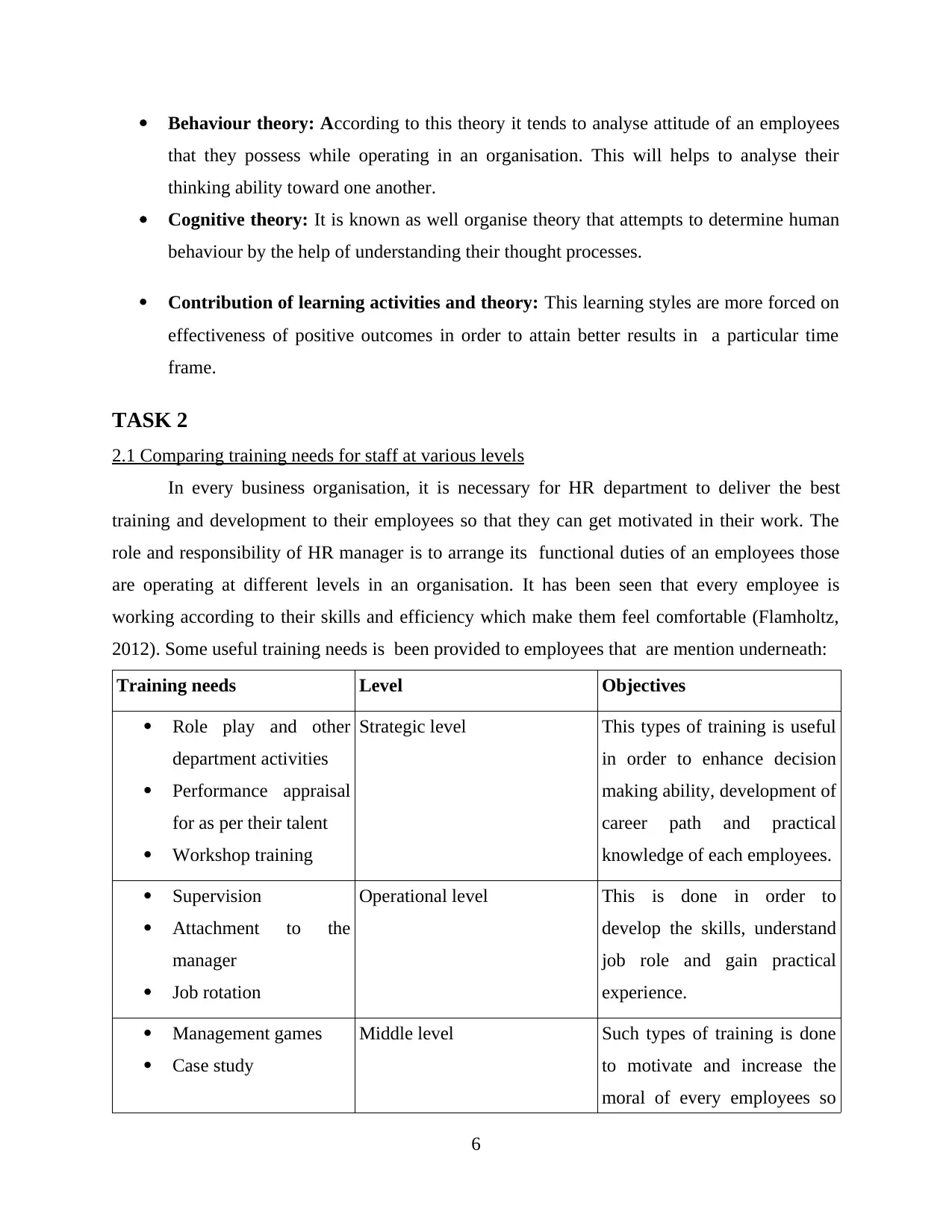
Behaviour theory: According to this theory it tends to analyse attitude of an employees
that they possess while operating in an organisation. This will helps to analyse their
thinking ability toward one another.
Cognitive theory: It is known as well organise theory that attempts to determine human
behaviour by the help of understanding their thought processes.
Contribution of learning activities and theory: This learning styles are more forced on
effectiveness of positive outcomes in order to attain better results in a particular time
frame.
TASK 2
2.1 Comparing training needs for staff at various levels
In every business organisation, it is necessary for HR department to deliver the best
training and development to their employees so that they can get motivated in their work. The
role and responsibility of HR manager is to arrange its functional duties of an employees those
are operating at different levels in an organisation. It has been seen that every employee is
working according to their skills and efficiency which make them feel comfortable (Flamholtz,
2012). Some useful training needs is been provided to employees that are mention underneath:
Training needs Level Objectives
Role play and other
department activities
Performance appraisal
for as per their talent
Workshop training
Strategic level This types of training is useful
in order to enhance decision
making ability, development of
career path and practical
knowledge of each employees.
Supervision
Attachment to the
manager
Job rotation
Operational level This is done in order to
develop the skills, understand
job role and gain practical
experience.
Management games
Case study
Middle level Such types of training is done
to motivate and increase the
moral of every employees so
6
that they possess while operating in an organisation. This will helps to analyse their
thinking ability toward one another.
Cognitive theory: It is known as well organise theory that attempts to determine human
behaviour by the help of understanding their thought processes.
Contribution of learning activities and theory: This learning styles are more forced on
effectiveness of positive outcomes in order to attain better results in a particular time
frame.
TASK 2
2.1 Comparing training needs for staff at various levels
In every business organisation, it is necessary for HR department to deliver the best
training and development to their employees so that they can get motivated in their work. The
role and responsibility of HR manager is to arrange its functional duties of an employees those
are operating at different levels in an organisation. It has been seen that every employee is
working according to their skills and efficiency which make them feel comfortable (Flamholtz,
2012). Some useful training needs is been provided to employees that are mention underneath:
Training needs Level Objectives
Role play and other
department activities
Performance appraisal
for as per their talent
Workshop training
Strategic level This types of training is useful
in order to enhance decision
making ability, development of
career path and practical
knowledge of each employees.
Supervision
Attachment to the
manager
Job rotation
Operational level This is done in order to
develop the skills, understand
job role and gain practical
experience.
Management games
Case study
Middle level Such types of training is done
to motivate and increase the
moral of every employees so
6
⊘ This is a preview!⊘
Do you want full access?
Subscribe today to unlock all pages.

Trusted by 1+ million students worldwide
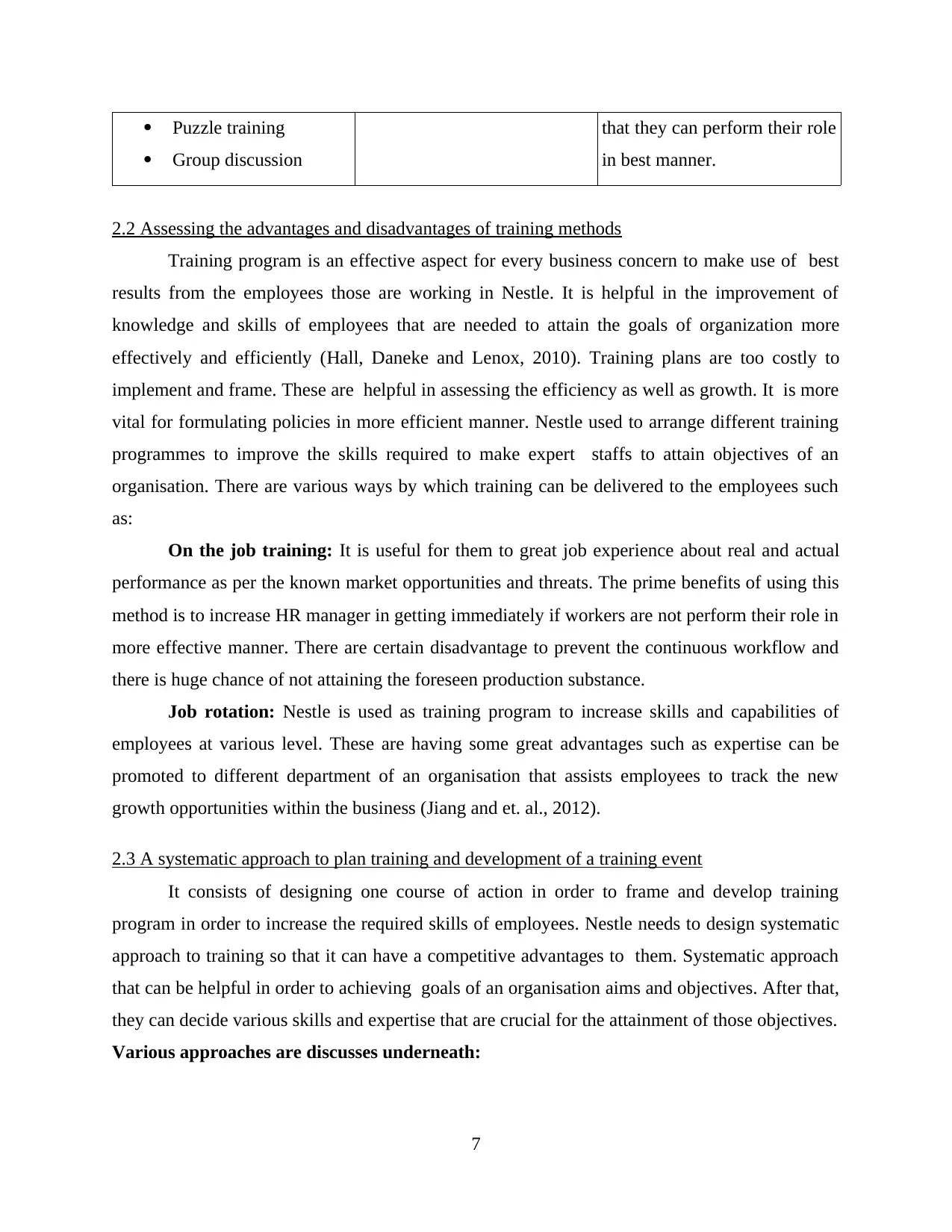
Puzzle training
Group discussion
that they can perform their role
in best manner.
2.2 Assessing the advantages and disadvantages of training methods
Training program is an effective aspect for every business concern to make use of best
results from the employees those are working in Nestle. It is helpful in the improvement of
knowledge and skills of employees that are needed to attain the goals of organization more
effectively and efficiently (Hall, Daneke and Lenox, 2010). Training plans are too costly to
implement and frame. These are helpful in assessing the efficiency as well as growth. It is more
vital for formulating policies in more efficient manner. Nestle used to arrange different training
programmes to improve the skills required to make expert staffs to attain objectives of an
organisation. There are various ways by which training can be delivered to the employees such
as:
On the job training: It is useful for them to great job experience about real and actual
performance as per the known market opportunities and threats. The prime benefits of using this
method is to increase HR manager in getting immediately if workers are not perform their role in
more effective manner. There are certain disadvantage to prevent the continuous workflow and
there is huge chance of not attaining the foreseen production substance.
Job rotation: Nestle is used as training program to increase skills and capabilities of
employees at various level. These are having some great advantages such as expertise can be
promoted to different department of an organisation that assists employees to track the new
growth opportunities within the business (Jiang and et. al., 2012).
2.3 A systematic approach to plan training and development of a training event
It consists of designing one course of action in order to frame and develop training
program in order to increase the required skills of employees. Nestle needs to design systematic
approach to training so that it can have a competitive advantages to them. Systematic approach
that can be helpful in order to achieving goals of an organisation aims and objectives. After that,
they can decide various skills and expertise that are crucial for the attainment of those objectives.
Various approaches are discusses underneath:
7
Group discussion
that they can perform their role
in best manner.
2.2 Assessing the advantages and disadvantages of training methods
Training program is an effective aspect for every business concern to make use of best
results from the employees those are working in Nestle. It is helpful in the improvement of
knowledge and skills of employees that are needed to attain the goals of organization more
effectively and efficiently (Hall, Daneke and Lenox, 2010). Training plans are too costly to
implement and frame. These are helpful in assessing the efficiency as well as growth. It is more
vital for formulating policies in more efficient manner. Nestle used to arrange different training
programmes to improve the skills required to make expert staffs to attain objectives of an
organisation. There are various ways by which training can be delivered to the employees such
as:
On the job training: It is useful for them to great job experience about real and actual
performance as per the known market opportunities and threats. The prime benefits of using this
method is to increase HR manager in getting immediately if workers are not perform their role in
more effective manner. There are certain disadvantage to prevent the continuous workflow and
there is huge chance of not attaining the foreseen production substance.
Job rotation: Nestle is used as training program to increase skills and capabilities of
employees at various level. These are having some great advantages such as expertise can be
promoted to different department of an organisation that assists employees to track the new
growth opportunities within the business (Jiang and et. al., 2012).
2.3 A systematic approach to plan training and development of a training event
It consists of designing one course of action in order to frame and develop training
program in order to increase the required skills of employees. Nestle needs to design systematic
approach to training so that it can have a competitive advantages to them. Systematic approach
that can be helpful in order to achieving goals of an organisation aims and objectives. After that,
they can decide various skills and expertise that are crucial for the attainment of those objectives.
Various approaches are discusses underneath:
7
Paraphrase This Document
Need a fresh take? Get an instant paraphrase of this document with our AI Paraphraser
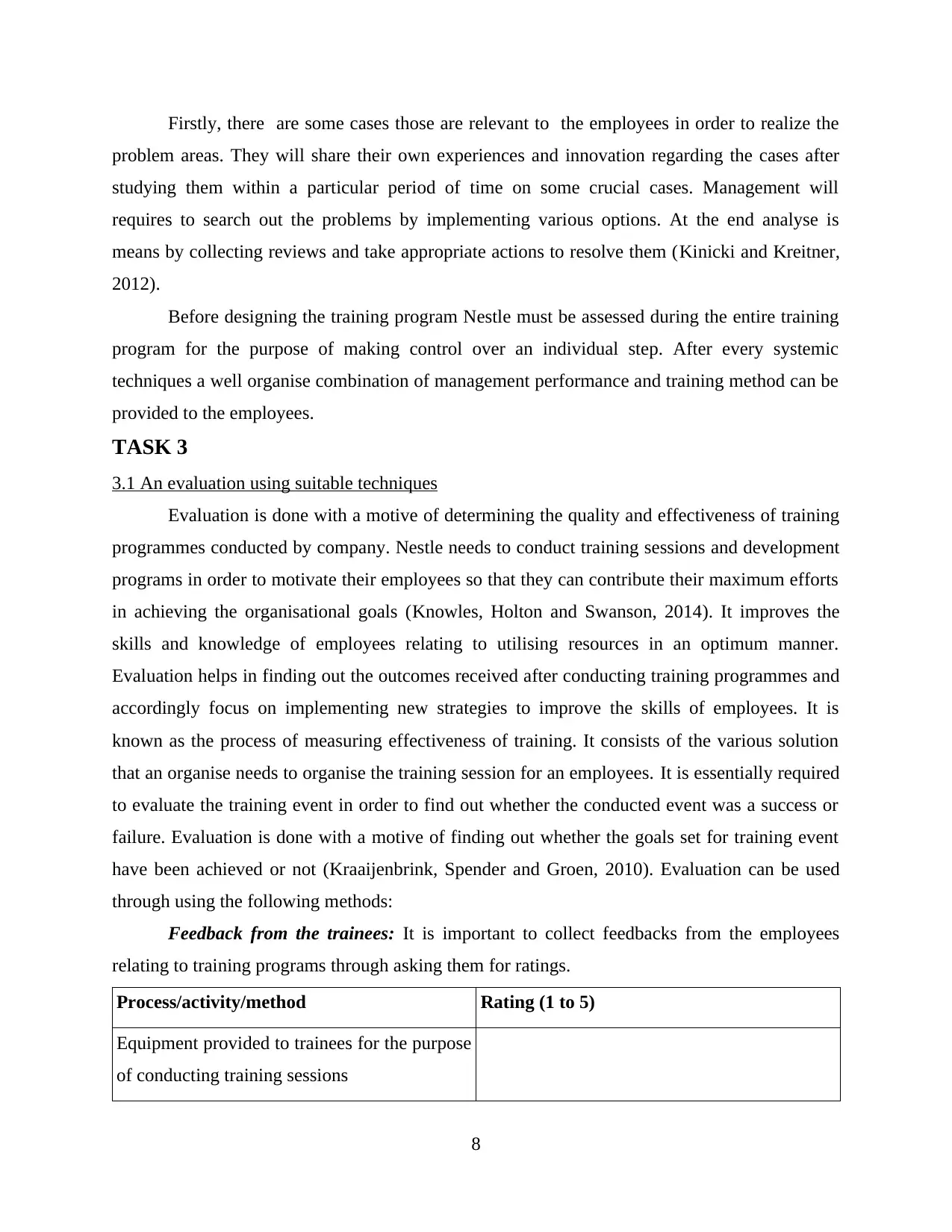
Firstly, there are some cases those are relevant to the employees in order to realize the
problem areas. They will share their own experiences and innovation regarding the cases after
studying them within a particular period of time on some crucial cases. Management will
requires to search out the problems by implementing various options. At the end analyse is
means by collecting reviews and take appropriate actions to resolve them (Kinicki and Kreitner,
2012).
Before designing the training program Nestle must be assessed during the entire training
program for the purpose of making control over an individual step. After every systemic
techniques a well organise combination of management performance and training method can be
provided to the employees.
TASK 3
3.1 An evaluation using suitable techniques
Evaluation is done with a motive of determining the quality and effectiveness of training
programmes conducted by company. Nestle needs to conduct training sessions and development
programs in order to motivate their employees so that they can contribute their maximum efforts
in achieving the organisational goals (Knowles, Holton and Swanson, 2014). It improves the
skills and knowledge of employees relating to utilising resources in an optimum manner.
Evaluation helps in finding out the outcomes received after conducting training programmes and
accordingly focus on implementing new strategies to improve the skills of employees. It is
known as the process of measuring effectiveness of training. It consists of the various solution
that an organise needs to organise the training session for an employees. It is essentially required
to evaluate the training event in order to find out whether the conducted event was a success or
failure. Evaluation is done with a motive of finding out whether the goals set for training event
have been achieved or not (Kraaijenbrink, Spender and Groen, 2010). Evaluation can be used
through using the following methods:
Feedback from the trainees: It is important to collect feedbacks from the employees
relating to training programs through asking them for ratings.
Process/activity/method Rating (1 to 5)
Equipment provided to trainees for the purpose
of conducting training sessions
8
problem areas. They will share their own experiences and innovation regarding the cases after
studying them within a particular period of time on some crucial cases. Management will
requires to search out the problems by implementing various options. At the end analyse is
means by collecting reviews and take appropriate actions to resolve them (Kinicki and Kreitner,
2012).
Before designing the training program Nestle must be assessed during the entire training
program for the purpose of making control over an individual step. After every systemic
techniques a well organise combination of management performance and training method can be
provided to the employees.
TASK 3
3.1 An evaluation using suitable techniques
Evaluation is done with a motive of determining the quality and effectiveness of training
programmes conducted by company. Nestle needs to conduct training sessions and development
programs in order to motivate their employees so that they can contribute their maximum efforts
in achieving the organisational goals (Knowles, Holton and Swanson, 2014). It improves the
skills and knowledge of employees relating to utilising resources in an optimum manner.
Evaluation helps in finding out the outcomes received after conducting training programmes and
accordingly focus on implementing new strategies to improve the skills of employees. It is
known as the process of measuring effectiveness of training. It consists of the various solution
that an organise needs to organise the training session for an employees. It is essentially required
to evaluate the training event in order to find out whether the conducted event was a success or
failure. Evaluation is done with a motive of finding out whether the goals set for training event
have been achieved or not (Kraaijenbrink, Spender and Groen, 2010). Evaluation can be used
through using the following methods:
Feedback from the trainees: It is important to collect feedbacks from the employees
relating to training programs through asking them for ratings.
Process/activity/method Rating (1 to 5)
Equipment provided to trainees for the purpose
of conducting training sessions
8
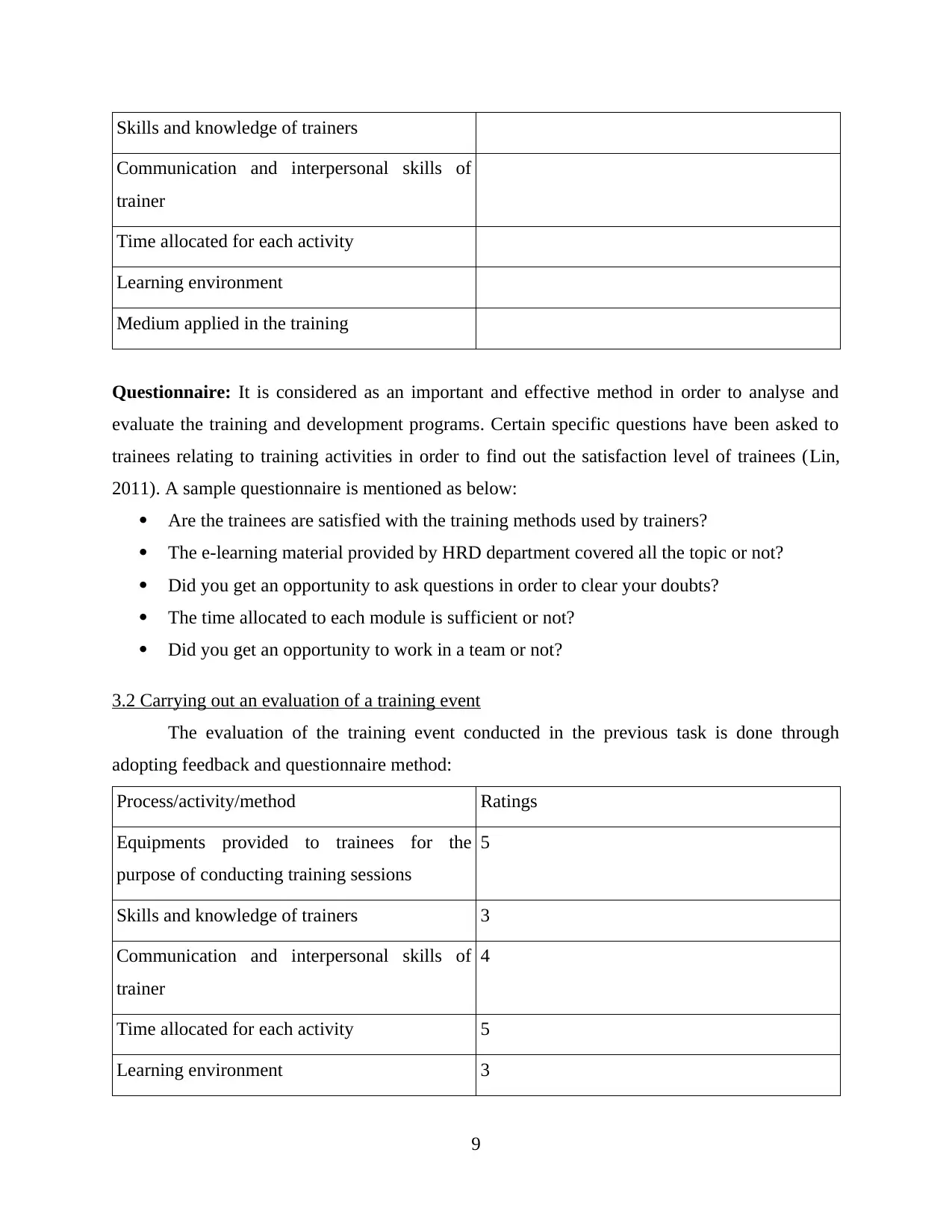
Skills and knowledge of trainers
Communication and interpersonal skills of
trainer
Time allocated for each activity
Learning environment
Medium applied in the training
Questionnaire: It is considered as an important and effective method in order to analyse and
evaluate the training and development programs. Certain specific questions have been asked to
trainees relating to training activities in order to find out the satisfaction level of trainees (Lin,
2011). A sample questionnaire is mentioned as below:
Are the trainees are satisfied with the training methods used by trainers?
The e-learning material provided by HRD department covered all the topic or not?
Did you get an opportunity to ask questions in order to clear your doubts?
The time allocated to each module is sufficient or not?
Did you get an opportunity to work in a team or not?
3.2 Carrying out an evaluation of a training event
The evaluation of the training event conducted in the previous task is done through
adopting feedback and questionnaire method:
Process/activity/method Ratings
Equipments provided to trainees for the
purpose of conducting training sessions
5
Skills and knowledge of trainers 3
Communication and interpersonal skills of
trainer
4
Time allocated for each activity 5
Learning environment 3
9
Communication and interpersonal skills of
trainer
Time allocated for each activity
Learning environment
Medium applied in the training
Questionnaire: It is considered as an important and effective method in order to analyse and
evaluate the training and development programs. Certain specific questions have been asked to
trainees relating to training activities in order to find out the satisfaction level of trainees (Lin,
2011). A sample questionnaire is mentioned as below:
Are the trainees are satisfied with the training methods used by trainers?
The e-learning material provided by HRD department covered all the topic or not?
Did you get an opportunity to ask questions in order to clear your doubts?
The time allocated to each module is sufficient or not?
Did you get an opportunity to work in a team or not?
3.2 Carrying out an evaluation of a training event
The evaluation of the training event conducted in the previous task is done through
adopting feedback and questionnaire method:
Process/activity/method Ratings
Equipments provided to trainees for the
purpose of conducting training sessions
5
Skills and knowledge of trainers 3
Communication and interpersonal skills of
trainer
4
Time allocated for each activity 5
Learning environment 3
9
⊘ This is a preview!⊘
Do you want full access?
Subscribe today to unlock all pages.

Trusted by 1+ million students worldwide
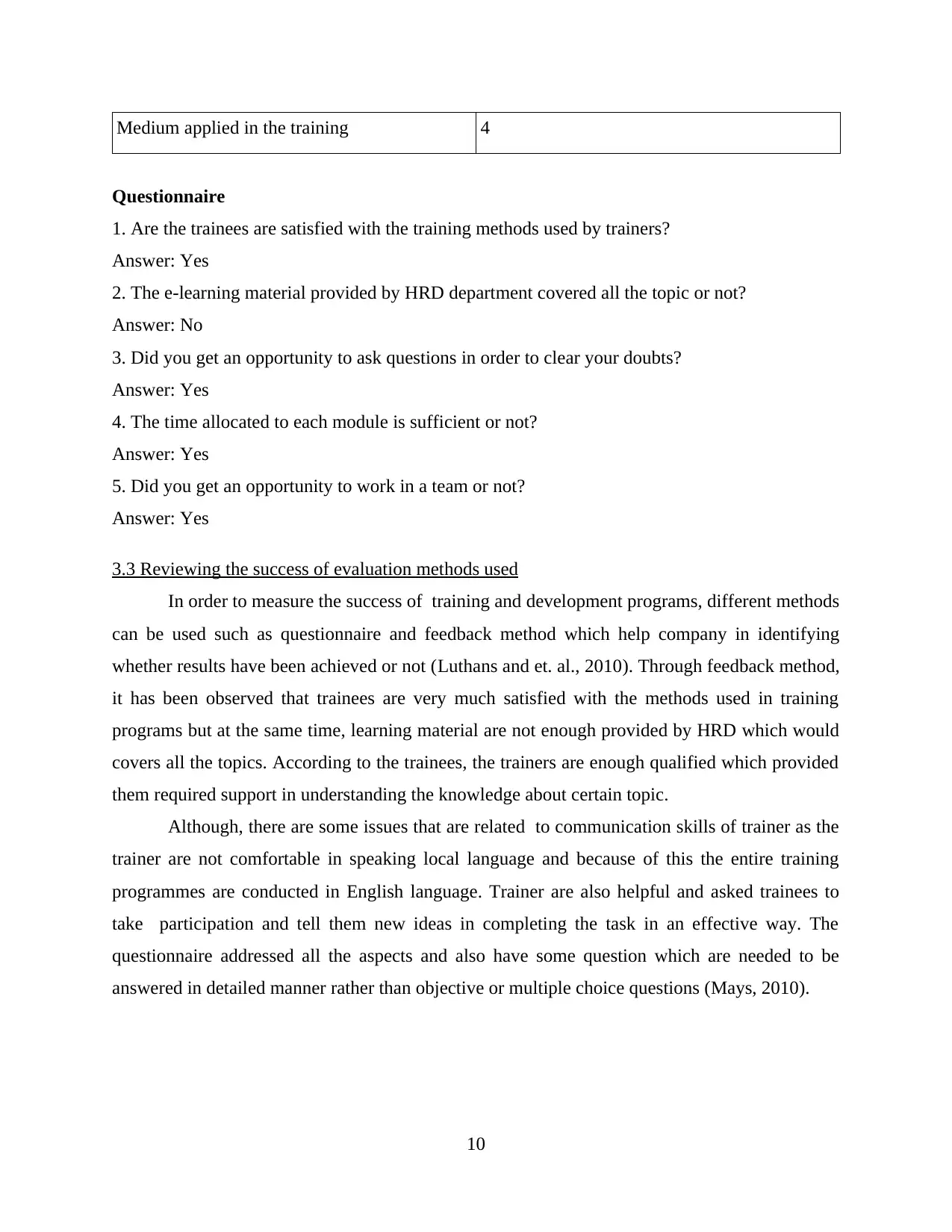
Medium applied in the training 4
Questionnaire
1. Are the trainees are satisfied with the training methods used by trainers?
Answer: Yes
2. The e-learning material provided by HRD department covered all the topic or not?
Answer: No
3. Did you get an opportunity to ask questions in order to clear your doubts?
Answer: Yes
4. The time allocated to each module is sufficient or not?
Answer: Yes
5. Did you get an opportunity to work in a team or not?
Answer: Yes
3.3 Reviewing the success of evaluation methods used
In order to measure the success of training and development programs, different methods
can be used such as questionnaire and feedback method which help company in identifying
whether results have been achieved or not (Luthans and et. al., 2010). Through feedback method,
it has been observed that trainees are very much satisfied with the methods used in training
programs but at the same time, learning material are not enough provided by HRD which would
covers all the topics. According to the trainees, the trainers are enough qualified which provided
them required support in understanding the knowledge about certain topic.
Although, there are some issues that are related to communication skills of trainer as the
trainer are not comfortable in speaking local language and because of this the entire training
programmes are conducted in English language. Trainer are also helpful and asked trainees to
take participation and tell them new ideas in completing the task in an effective way. The
questionnaire addressed all the aspects and also have some question which are needed to be
answered in detailed manner rather than objective or multiple choice questions (Mays, 2010).
10
Questionnaire
1. Are the trainees are satisfied with the training methods used by trainers?
Answer: Yes
2. The e-learning material provided by HRD department covered all the topic or not?
Answer: No
3. Did you get an opportunity to ask questions in order to clear your doubts?
Answer: Yes
4. The time allocated to each module is sufficient or not?
Answer: Yes
5. Did you get an opportunity to work in a team or not?
Answer: Yes
3.3 Reviewing the success of evaluation methods used
In order to measure the success of training and development programs, different methods
can be used such as questionnaire and feedback method which help company in identifying
whether results have been achieved or not (Luthans and et. al., 2010). Through feedback method,
it has been observed that trainees are very much satisfied with the methods used in training
programs but at the same time, learning material are not enough provided by HRD which would
covers all the topics. According to the trainees, the trainers are enough qualified which provided
them required support in understanding the knowledge about certain topic.
Although, there are some issues that are related to communication skills of trainer as the
trainer are not comfortable in speaking local language and because of this the entire training
programmes are conducted in English language. Trainer are also helpful and asked trainees to
take participation and tell them new ideas in completing the task in an effective way. The
questionnaire addressed all the aspects and also have some question which are needed to be
answered in detailed manner rather than objective or multiple choice questions (Mays, 2010).
10
Paraphrase This Document
Need a fresh take? Get an instant paraphrase of this document with our AI Paraphraser
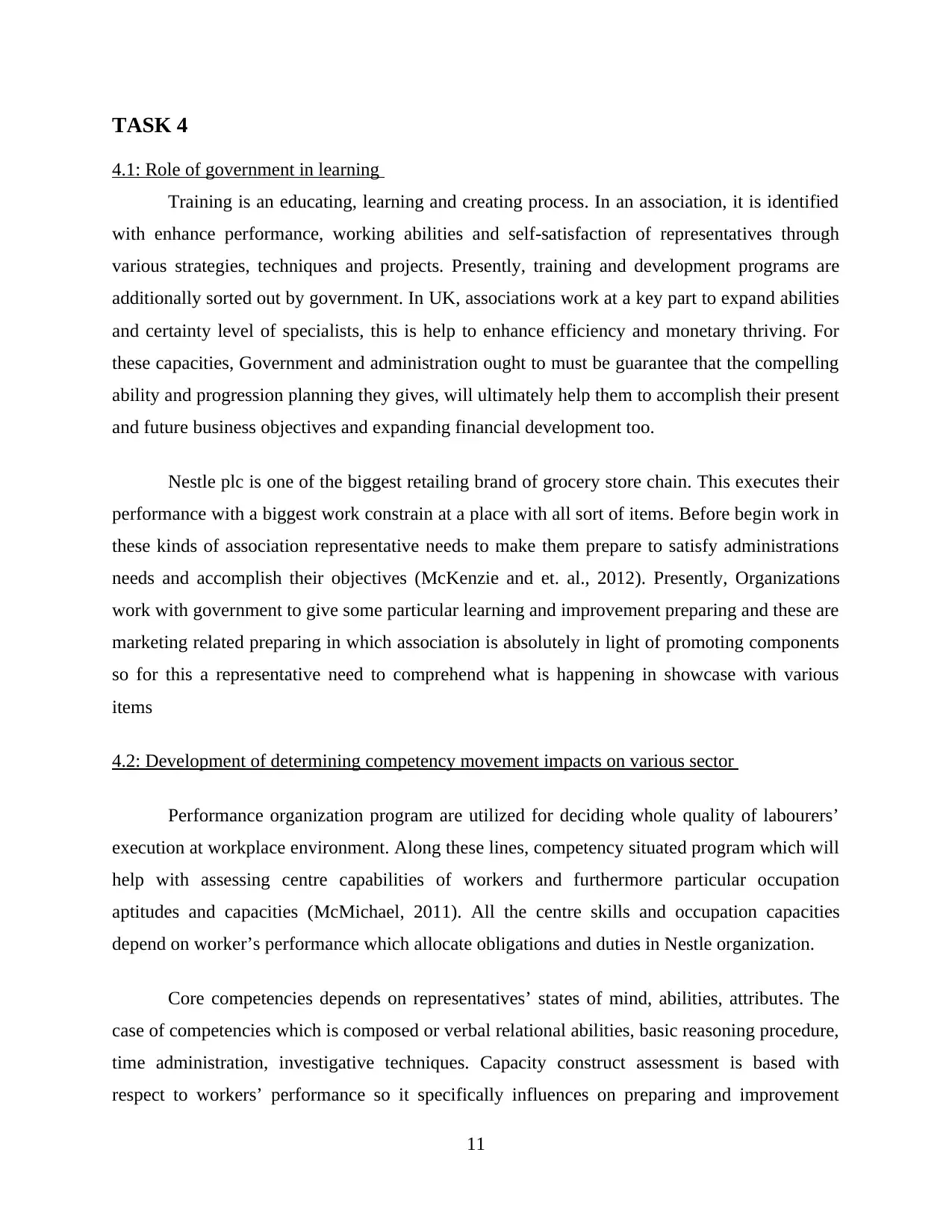
TASK 4
4.1: Role of government in learning
Training is an educating, learning and creating process. In an association, it is identified
with enhance performance, working abilities and self-satisfaction of representatives through
various strategies, techniques and projects. Presently, training and development programs are
additionally sorted out by government. In UK, associations work at a key part to expand abilities
and certainty level of specialists, this is help to enhance efficiency and monetary thriving. For
these capacities, Government and administration ought to must be guarantee that the compelling
ability and progression planning they gives, will ultimately help them to accomplish their present
and future business objectives and expanding financial development too.
Nestle plc is one of the biggest retailing brand of grocery store chain. This executes their
performance with a biggest work constrain at a place with all sort of items. Before begin work in
these kinds of association representative needs to make them prepare to satisfy administrations
needs and accomplish their objectives (McKenzie and et. al., 2012). Presently, Organizations
work with government to give some particular learning and improvement preparing and these are
marketing related preparing in which association is absolutely in light of promoting components
so for this a representative need to comprehend what is happening in showcase with various
items
4.2: Development of determining competency movement impacts on various sector
Performance organization program are utilized for deciding whole quality of labourers’
execution at workplace environment. Along these lines, competency situated program which will
help with assessing centre capabilities of workers and furthermore particular occupation
aptitudes and capacities (McMichael, 2011). All the centre skills and occupation capacities
depend on worker’s performance which allocate obligations and duties in Nestle organization.
Core competencies depends on representatives’ states of mind, abilities, attributes. The
case of competencies which is composed or verbal relational abilities, basic reasoning procedure,
time administration, investigative techniques. Capacity construct assessment is based with
respect to workers’ performance so it specifically influences on preparing and improvement
11
4.1: Role of government in learning
Training is an educating, learning and creating process. In an association, it is identified
with enhance performance, working abilities and self-satisfaction of representatives through
various strategies, techniques and projects. Presently, training and development programs are
additionally sorted out by government. In UK, associations work at a key part to expand abilities
and certainty level of specialists, this is help to enhance efficiency and monetary thriving. For
these capacities, Government and administration ought to must be guarantee that the compelling
ability and progression planning they gives, will ultimately help them to accomplish their present
and future business objectives and expanding financial development too.
Nestle plc is one of the biggest retailing brand of grocery store chain. This executes their
performance with a biggest work constrain at a place with all sort of items. Before begin work in
these kinds of association representative needs to make them prepare to satisfy administrations
needs and accomplish their objectives (McKenzie and et. al., 2012). Presently, Organizations
work with government to give some particular learning and improvement preparing and these are
marketing related preparing in which association is absolutely in light of promoting components
so for this a representative need to comprehend what is happening in showcase with various
items
4.2: Development of determining competency movement impacts on various sector
Performance organization program are utilized for deciding whole quality of labourers’
execution at workplace environment. Along these lines, competency situated program which will
help with assessing centre capabilities of workers and furthermore particular occupation
aptitudes and capacities (McMichael, 2011). All the centre skills and occupation capacities
depend on worker’s performance which allocate obligations and duties in Nestle organization.
Core competencies depends on representatives’ states of mind, abilities, attributes. The
case of competencies which is composed or verbal relational abilities, basic reasoning procedure,
time administration, investigative techniques. Capacity construct assessment is based with
respect to workers’ performance so it specifically influences on preparing and improvement
11
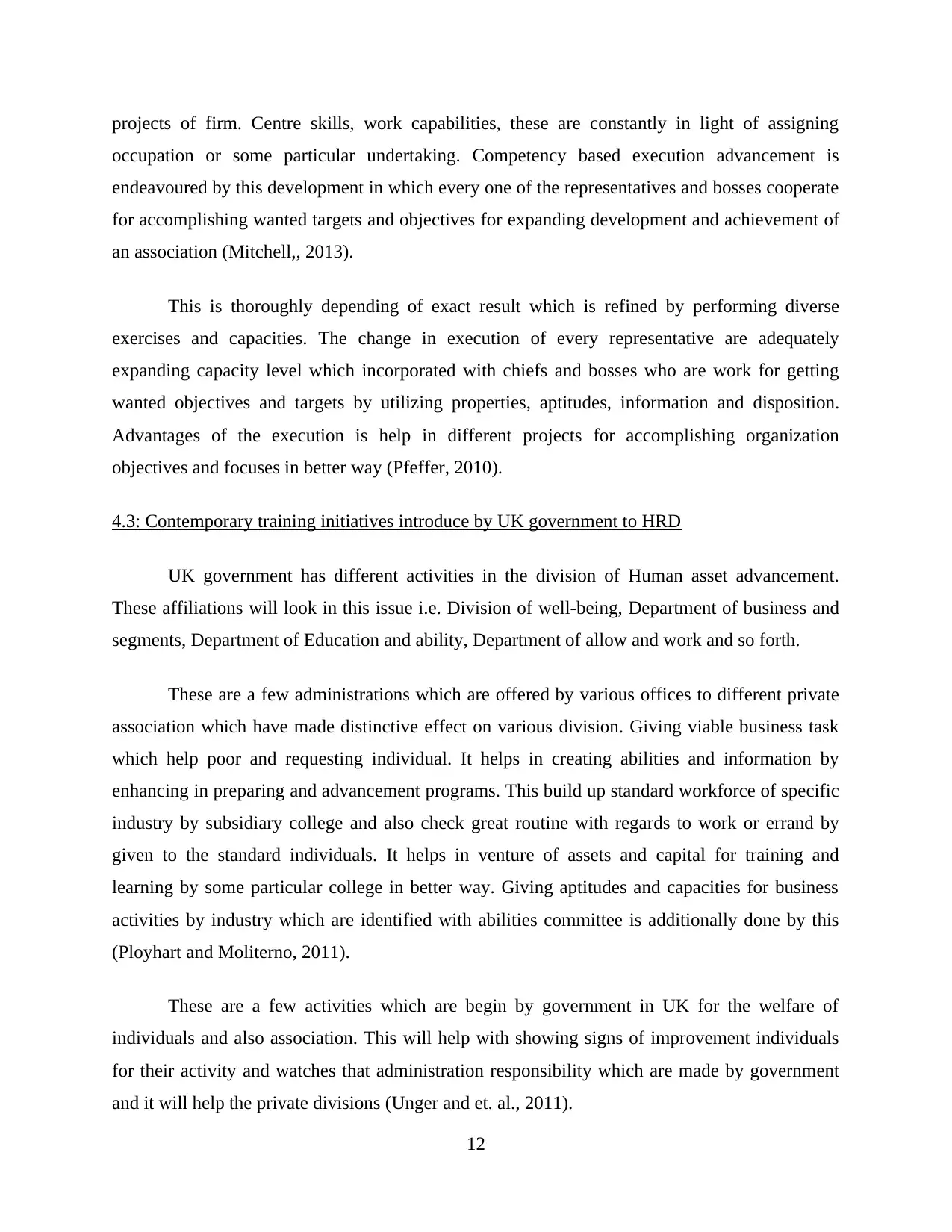
projects of firm. Centre skills, work capabilities, these are constantly in light of assigning
occupation or some particular undertaking. Competency based execution advancement is
endeavoured by this development in which every one of the representatives and bosses cooperate
for accomplishing wanted targets and objectives for expanding development and achievement of
an association (Mitchell,, 2013).
This is thoroughly depending of exact result which is refined by performing diverse
exercises and capacities. The change in execution of every representative are adequately
expanding capacity level which incorporated with chiefs and bosses who are work for getting
wanted objectives and targets by utilizing properties, aptitudes, information and disposition.
Advantages of the execution is help in different projects for accomplishing organization
objectives and focuses in better way (Pfeffer, 2010).
4.3: Contemporary training initiatives introduce by UK government to HRD
UK government has different activities in the division of Human asset advancement.
These affiliations will look in this issue i.e. Division of well-being, Department of business and
segments, Department of Education and ability, Department of allow and work and so forth.
These are a few administrations which are offered by various offices to different private
association which have made distinctive effect on various division. Giving viable business task
which help poor and requesting individual. It helps in creating abilities and information by
enhancing in preparing and advancement programs. This build up standard workforce of specific
industry by subsidiary college and also check great routine with regards to work or errand by
given to the standard individuals. It helps in venture of assets and capital for training and
learning by some particular college in better way. Giving aptitudes and capacities for business
activities by industry which are identified with abilities committee is additionally done by this
(Ployhart and Moliterno, 2011).
These are a few activities which are begin by government in UK for the welfare of
individuals and also association. This will help with showing signs of improvement individuals
for their activity and watches that administration responsibility which are made by government
and it will help the private divisions (Unger and et. al., 2011).
12
occupation or some particular undertaking. Competency based execution advancement is
endeavoured by this development in which every one of the representatives and bosses cooperate
for accomplishing wanted targets and objectives for expanding development and achievement of
an association (Mitchell,, 2013).
This is thoroughly depending of exact result which is refined by performing diverse
exercises and capacities. The change in execution of every representative are adequately
expanding capacity level which incorporated with chiefs and bosses who are work for getting
wanted objectives and targets by utilizing properties, aptitudes, information and disposition.
Advantages of the execution is help in different projects for accomplishing organization
objectives and focuses in better way (Pfeffer, 2010).
4.3: Contemporary training initiatives introduce by UK government to HRD
UK government has different activities in the division of Human asset advancement.
These affiliations will look in this issue i.e. Division of well-being, Department of business and
segments, Department of Education and ability, Department of allow and work and so forth.
These are a few administrations which are offered by various offices to different private
association which have made distinctive effect on various division. Giving viable business task
which help poor and requesting individual. It helps in creating abilities and information by
enhancing in preparing and advancement programs. This build up standard workforce of specific
industry by subsidiary college and also check great routine with regards to work or errand by
given to the standard individuals. It helps in venture of assets and capital for training and
learning by some particular college in better way. Giving aptitudes and capacities for business
activities by industry which are identified with abilities committee is additionally done by this
(Ployhart and Moliterno, 2011).
These are a few activities which are begin by government in UK for the welfare of
individuals and also association. This will help with showing signs of improvement individuals
for their activity and watches that administration responsibility which are made by government
and it will help the private divisions (Unger and et. al., 2011).
12
⊘ This is a preview!⊘
Do you want full access?
Subscribe today to unlock all pages.

Trusted by 1+ million students worldwide
1 out of 15
Related Documents
Your All-in-One AI-Powered Toolkit for Academic Success.
+13062052269
info@desklib.com
Available 24*7 on WhatsApp / Email
![[object Object]](/_next/static/media/star-bottom.7253800d.svg)
Unlock your academic potential
Copyright © 2020–2025 A2Z Services. All Rights Reserved. Developed and managed by ZUCOL.





